The Half Dome Hike in Yosemite National Park is a thrilling adventure for brave hikers. Scaling the epic cables to reach the summit offers breathtaking views and a challenging experience. This iconic trek is not for the faint of heart, but it’s a chance to conquer nature’s ultimate staircase and witness the beauty of one of America’s most revered national parks.
If you love the outdoors and want an exciting adventure, try the cable climb at Half Dome. It’s a challenging and unforgettable journey through a beautiful natural wonder in California. So, put on your boots, bring water and sunscreen, and get ready for the hike of a lifetime!
Quick Facts
- Distance: 16.5 miles (26.5 km) round trip
- Elevation Gain: 5,300 feet (1,615 m)
- Top Elevation: 8,844 feet (2,695 m)
- Duration: 9 – 12 hours round trip
- Difficulty: Hard
What And Where Is Half Dome?
Half Dome is a big rock in Yosemite National Park, California, USA. It is famous for its unique shape and stands 8,839 feet (2,694 meters) above sea level. People like to hike and climb Half Dome, especially using the cable route on the steep side.
The hike is challenging but worth it for the fantastic views. Half Dome symbolizes adventure for people who love the outdoors and visit Half Dome Hike Yosemite National Park.
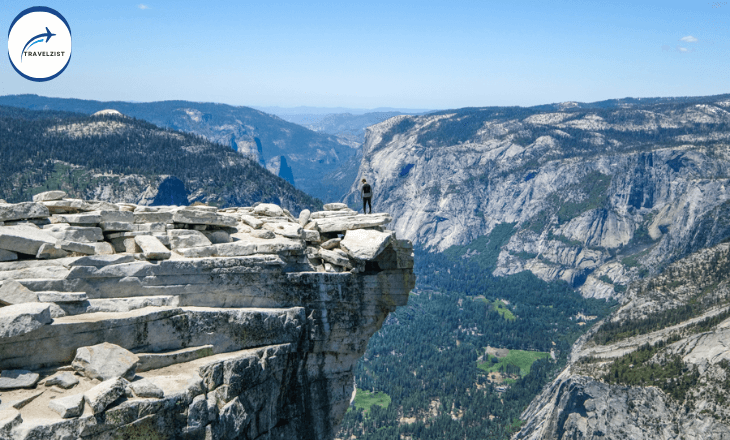
Half Dome Hike: What To Expect
The Half Dome hike is challenging but worth it, with amazing views of Yosemite National Park. The trail is about 16 miles round trip and has steep, rocky parts and a section with cables to help you climb the last stretch to the top.
Be ready for different weather, so bring the right clothes and gear. As you go up, you’ll see stunning views of the area and feel proud when you reach the top.
Mist Trail vs John Muir Trail (JMT)
The Mist Trail and the John Muir Trail (JMT) are well-liked hiking paths in Yosemite National Park. It is a challenging, shorter hike that leads to the top of Vernal Fall and then to Nevada Fall. It’s known for its steep rock steps and close-up views of the waterfalls.
The JMT is a longer trek that lasts several days and covers over 200 miles, passing through beautiful landscapes in the Sierra Nevada mountains.
The Mist Trail is an excellent choice for a challenging hike with stunning waterfall views. If you want a more extended backpacking adventure through different terrain and mountain views, the JMT offers an unmatched experience. Both trails display the natural beauty of Yosemite and provide chances for outdoor enthusiasts to connect with nature in unique ways.
Half Dome Trail Map
The Half Dome Trail map shows the trail sections and routes to reach Yosemite National Park’s Half Dome summit. The orange area is the main trail to the base of Half Dome, and the blue section is the challenging ascent up the sub-dome.
Hikers can use the map to plan their route based on their fitness level and desired difficulty. Studying the map before starting the hike is essential, considering factors like elevation gain, distance, and terrain.
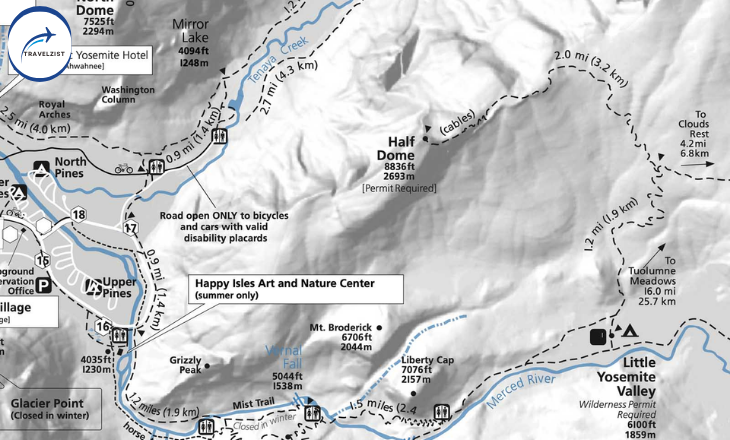
Part 1 / 7: The Mist Trail To Vernal Falls
Part 1 of the Mist Trail in Half Dome Hike Yosemite National Park is a popular hiking route to Vernal Falls. It’s about 1.5 miles long and has moderate difficulty, so hikers of different experience levels can enjoy it. The trail has steep granite steps and great views of the landscape.
The main attraction is Vernal Falls, a powerful and beautiful waterfall from the Merced River. Hikers can feel the mist from the falls, which makes it a unique experience.
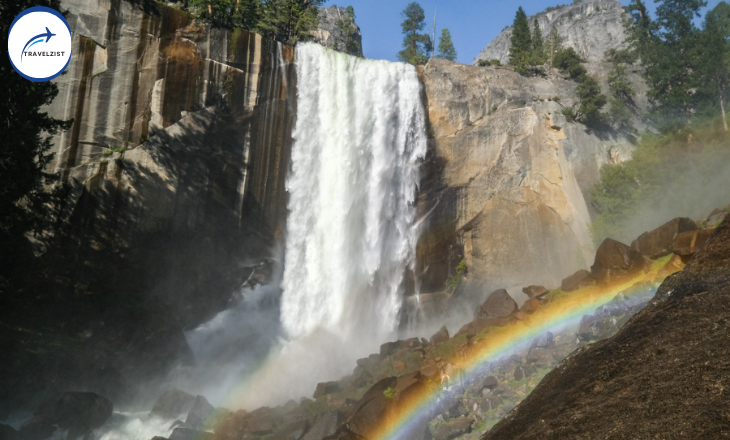
Part 2 / 7: Vernal Falls To Nevada Falls
Part 2 of the hike from Vernal Falls to Nevada Falls in Yosemite National Park is beautiful. The trail follows the Merced River and has great views of waterfalls and green plants. The hike is moderate to hard, with steep parts and rocks, so wear good shoes and bring lots of water.
As you get closer to Nevada Falls, you’ll see wide views of the mountains and valleys. The mist from the falls makes the air cool and nice, so it’s a good place to rest and enjoy the nature. Look out for birds and small animals along the trail.
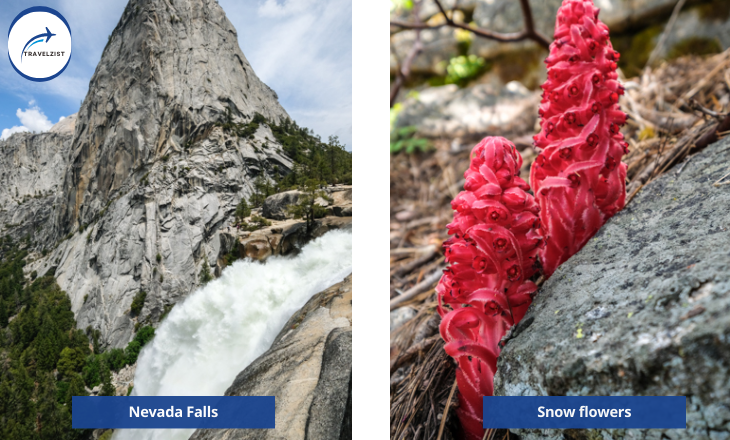
Part 3 / 7: Little Yosemite Valley To Sub Dome
The trail goes through pretty meadows and has excellent mountain views. It’s a steady uphill climb, so enjoy the scenery slowly. The ground gets rough and steep as you get closer to Sub Dome. Be careful because it can be slippery. When you reach Sub Dome, you’ll see fantastic valley views and feel proud. Remember to drink water and take breaks during this challenging hike.
Part 4 / 7: Climbing The Sub Dome
Climbing the Sub Dome in Part 4 of the hike is an exciting and challenging experience. The Sub Dome is a steep slope of rock that leads to the final climb to the top of Half Dome, offering fantastic views along the way.
As you climb the switchbacks and rocky ground, staying focused and careful is essential, especially in bad weather. Many hikers find this part of the trail physically demanding, so having the right shoes, water, and energy snacks is essential.
Part 5 / 7: Half Dome Cables Section
In Part 5 of the hike, you’ll reach the famous Half Dome Cables section. Here, you’ll climb a steep granite slope using metal cables for support. It’s a thrilling and challenging experience that needs physical strength and mental focus. Wear strong shoes with good grip and bring gloves for holding the cables.
Part 6 / 7: Top Of Half Dome Summit
The last parts of the Half Dome Summit trail are Parts 6 and 7. They lead to the top of Half Dome in Yosemite National Park. Part 6 has the famous cables section, where hikers use cables and wooden planks to climb the steep slope. It’s physically demanding but gives fantastic views of the park.
Part 7 is the top, with stunning views of Yosemite Valley, Glacier Point, and the High Sierra. It’s a great place to rest and enjoy the scenery. Prepare well, wear good shoes, bring water, and watch the weather.
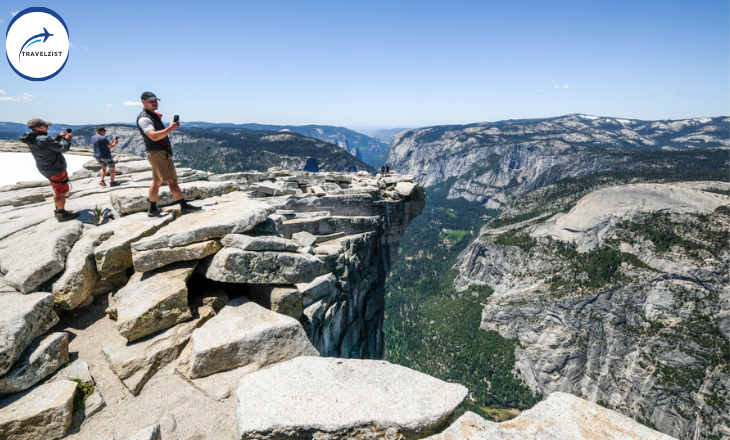
Part 7 / 7: Going Back Down
The plot gets resolved in part 7 of the story, and the characters return to their everyday lives. This part ties up loose ends and gives closure to the reader. It also shows how the events have affected the characters. In Going Back Down, readers will see what happens after the big moment, including any lasting effects from earlier events.
Half Dome Elevation: How Tall Is Half Dome?
The trail gains over 4,800 feet in elevation, making it a strenuous and demanding trek that requires physical fitness and mental preparation. Hikers should also know that permits are required for the final cable ascent, typically available through a lottery system due to high demand. The Yosemite Half Dome Hike is an unforgettable adventure that offers stunning views of Yosemite Valley and surrounding peaks.
How Safe Is The Half Dome?
The safety of the hike depends on how prepared and fit the hiker is and if they follow safety rules. The trail is challenging, with steep parts and cables near the top. Hikers should know the weather, bring good gear like strong shoes and lots of water, and be careful on the steep parts. In recent years, some hikers have gotten hurt or died on the hike, usually from falls or lightning. But many hikers finish the hike safely by being careful and paying attention.
Half Dome Hike Deaths
The Half Dome Hike Deaths in Yosemite National Park is a challenging and strenuous trek that has unfortunately resulted in several deaths over the years. The most common causes of death on this hike include falls, lightning strikes, and heart attacks.
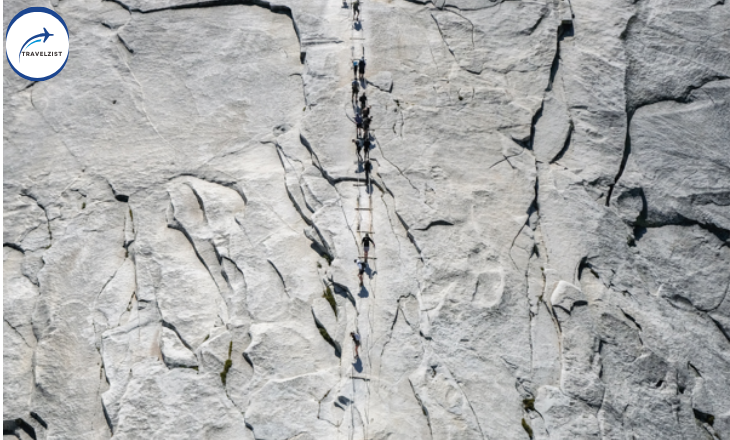
To minimize the risk of accidents, hikers should always check weather conditions before starting the hike, wear appropriate footwear, carry plenty of water and snacks, and be prepared for sudden weather changes.
What To Bring To Half Dome Yosemite
It would help to have strong hiking boots with good ankle support for the rugged terrain. Bring lots of water or a water filter because there isn’t much water on the trail. Also, bring high-energy snacks like trail mix, energy bars, and fruit to keep your energy up during the strenuous hike.
Other things to bring are a light backpack, sunscreen, a hat, and layered clothing for different weather. Don’t forget your camera to take pictures of the fantastic views from the top of Half Dome!
Should You Use A Harness For Half Dome?
The climb is challenging, and a well-fitted harness adds extra security in case of a slip or fall. Make sure to choose a harness designed for rock climbing and meets safety standards. The harness helps you connect to a rope system for safety and controlled descent.
Before climbing Half Dome, get proper training and know how to use the harness and climbing gear. Using a harness can make you feel safer and more confident when climbing Half Dome.
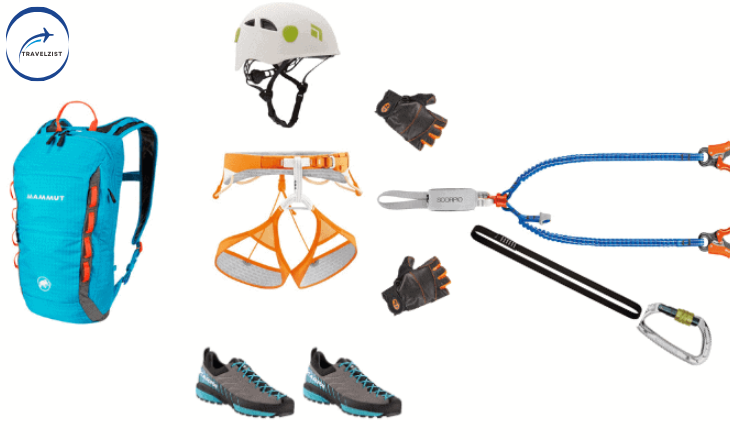
Other Tips For Half Dome Yosemite
Here are some additional tips for hiking Half Dome in Yosemite:
1. Start early: Half Dome is a popular and challenging hike, so it’s essential to start early to avoid crowds and give yourself plenty of time to complete the hike.
2. Be prepared for the cables: The final ascent to the summit of Half Dome involves climbing steep lines. Ensure you have gloves with good grip, and be ready for a strenuous climb.
3. Check the weather: Weather conditions can change rapidly in Yosemite, so checking the forecast before starting your hike is essential. Avoid hiking Half Dome in stormy or windy conditions, as it can be dangerous.
When To Start The Half Dome Hike
The best time to start the hike is early morning, before sunrise. This helps hikers avoid the midday heat and crowds on the trail. Starting early also gives you enough time to finish the hike and enjoy the incredible views from the top without feeling rushed.
The hike is challenging and can take many hours, so starting early ensures enough daylight to navigate the trail safely. Starting early reduces congestion on narrow parts of the trail and at popular viewpoints.
Half Dome Trailhead: How To Get There
Take the shuttle bus from different locations in the park to get there. The shuttle runs during the busy season, from late spring to early fall. It’s a convenient way to reach the trail without worrying about parking.
The course is about 14-16 miles round trip and has steep sections with cables for climbing near the top. Make sure to have the right hiking gear, lots of water, and a permit if you plan to hike past the base of Half Dome. Also, check for any trail closures or restrictions before you go.
Is Half Dome Open / Closed?
Hikers can visit Half Dome in Yosemite National Park with a valid permit. The park uses a reservation system to manage the impact on the trail and the surrounding environment. Hikers must get a ticket in advance through the recreation.gov website and check for updates before planning their visit.
Weather and other factors can affect access to Half Dome, so it’s best to check the official Yosemite National Park website or contact the park directly for the latest trail status and permit information.
U.S. National Park Regulations
U.S. National Park rules protect the environment and ensure visitors have a good time. They limit camping, hiking, and fishing to keep the environment safe. The regulations also provide that people don’t bother the animals and properly dispose of their trash to protect the park’s delicate ecosystems.
Entrance Fee
The entrance fee for most attractions and events can vary widely depending on the location, type of attraction, and time of year. Popular tourist destinations and significant events may have higher entrance fees, while smaller or less well-known attractions may have lower or no entrance fees. It’s always a good idea to check the official website or contact the venue directly to get the most accurate information about entrance fees before planning your visit.
Half Dome Lottery Permit System
The Half Dome Lottery Permit System lets hikers get a permit to hike to the top of Half Dome in Yosemite National Park. To join the lottery, hikers must apply during a specific time. If chosen, they get a permit for a particular date to hike Half Dome. Tickets can’t be given to someone else, so each person must apply for themselves.
The lottery system aims to provide fair access and reduce overcrowding on the trail so more hikers can experience the famous summit while protecting the natural environment. If you plan to hike Half Dome, understand the lottery process and apply during the set time to get a permit.
How To Get Half Dome hike Permits
To get permits for Half Dome in Yosemite National Park, you can enter the preseason or daily lottery. The preseason lottery opens in March and lets you pick your preferred hiking dates.

If you don’t win the preseason lottery, you can try the daily lottery, available two days before your desired hiking date. You can also buy a limited number of permits on recreation.gov. Plan and be flexible with your travel dates to improve your chances of getting a ticket.
Can You Hike Half Dome Without A Permit?
No, you can’t hike Half Dome without a permit. The hike is popular and challenging, so you need a permit in advance. This is to manage the high number of visitors and keep hikers safe on the steep trail. Everyone going to the summit, whether for the day or overnight, needs a permit. Permits are given out through a lottery system, with only a few available daily during the hiking season. Planning and applying for permits early is essential if you want to do this hike.
Half Dome Via Glacier Point & Panorama Trail
The hike via Glacier Point and Panorama Trail is a challenging but rewarding experience for hikers who want amazing views of Yosemite National Park. The trail starts at Glacier Point, with stunning views of the park, then goes down into the valley. Hikers will see different landscapes, like forests, waterfalls, and meadows. The final climb to the top involves using the famous cables, which can be scary but is worth it for those who make it to the top.
More U.S. National Park Travel Guides
Many travel guides help explore U.S. National Parks. You can find guidebooks like National Geographic’s Guide to the United States National Parks. These guides give detailed information on park attractions, hiking trails, wildlife, and more. Individual national parks have their principles and websites with information on facilities, activities, and accommodations.
The National Park Service’s official site and other travel websites also offer helpful resources for planning your visit. Whether you like camping, hiking, wildlife viewing, or just enjoying the natural beauty, many guides help you make the most of your experience.
Conclusion
Half Dome hike offers a truly unforgettable experience in Yosemite National Park. The challenging yet rewarding ascent gives hikers breathtaking views and a sense of accomplishment. With proper preparation and respect for the environment, this adventure can be enjoyed by outdoor enthusiasts of various skill levels.
As one of the most iconic hikes in the country, it is essential to remember to follow park regulations and guidelines to ensure safety for yourself and others. So, if you’re seeking an exhilarating challenge that promises stunning vistas and a genuine connection with nature, consider adding the hike to your bucket list—it’s an experience like no other.
FAQs
How Hard Is The Half Dome Hike Distance?
The half dome hike distance is about 14-16 miles round trip, depending on where you start and which way you go. It’s a tough hike that needs good physical fitness and endurance. The trail goes up over 4,800 feet and has steep, rocky parts, and the famous cable section near the top.
How Long Is Half Dome Hike?
The hike in Yosemite National Park is about 14 to 16 miles round trip, depending on your chosen route. The most popular and challenging course starts at the Happy Isles trailhead and involves a steep climb up the Mist Trail and the famous cable section near the top.
Can you Hike Half Dome at Night?
Yes, it is possible to hike Half Dome at night, but it is not recommended for inexperienced hikers or those unfamiliar with the trail.
- El Nido Palawan Island Travel Guide For The Philippines - 29 May 2024
- Uluwatu Bali: 20 Best Things To Do In Uluwatu - 28 May 2024
- Breckenridge Troll Hike: Isak Heartstone Location & Directions - 24 May 2024

